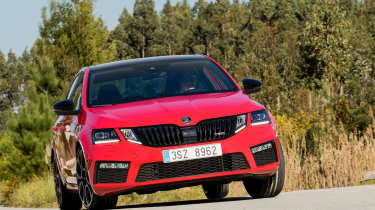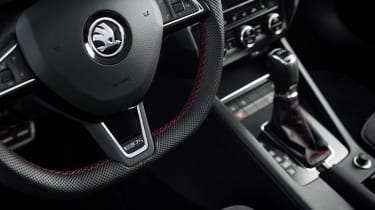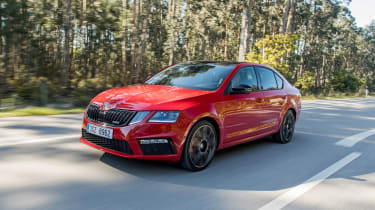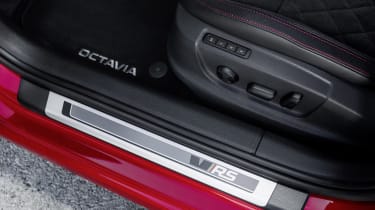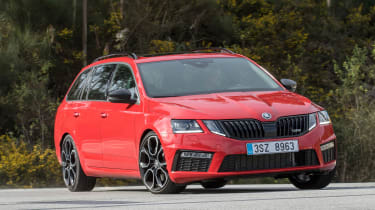Skoda Octavia vRS 245 review - the hottest Octavia gets hotter
The practical Czech hatchback has more than just a hint of sportiness in vRS 245 guise
The Octavia is currently the only model in Skoda’s line-up to be given the full vRS treatment, but with a diesel and two petrol options there’s still a bit of choice when it comes to selecting your hot Skoda.
The latest car to be launched is the Octavia vRS 245, the most powerful and, thanks to a selection of tasty sounding upgrades over the conventional petrol vRS, the most promising of the bunch.
The 245 gets a power hike of 15bhp over the standard model to give it a total of 242bhp. There’s also a new exhaust with smaller mufflers and redesigned back-boxes to increase noise and reduce back pressure.
The increase in engine performance is accompanied by some larger brakes, the discs now 340mm at the front and 310mm at the rear. The big stoppers mean the 245 has to come with larger wheels as standard and gets 19-inch black rims with machined details. To help identify the 245 over the regular Octavia vRS, and give it a smidgen of extra aggression, the car also gets a black grill, bumper trims and mirror caps.
With a comprehensive list of upgrades the 245 is to the normal petrol Octavia vRS what the Volkswagen Golf GTI Performance Pack is to the basic Golf GTI.
Technical highlights
As well as the power, the wheels, exhaust, brakes and black trim, the vRS 245 is equipped with the Volkswagen Group’s VAQ electronically limited slip differential. Unlike conventional LSDs, or even other e-diffs, the VAQ’s locking element sits outside of the diff cage. Instead, it's positioned to the right-hand side on the driveshaft.
More reviews
An electric pump supplies the VAQ unit with varying degrees of pressurised hydraulic fluid; this oil operates a pack of clutches that can lock the driveshaft to the diff cage, and therefore, essentially, the other driveshaft too. The greater the pressure, the higher the percentage of lock and the closer the speed of the two front wheels.
With an active electronically controlled system like this, the car can immediately send torque to the outside wheel to aid turn-in rather than reacting to torque input from the engine like a purely mechanical system has to. It can also remain fully open when the extra traction, or a torque vectoring effect, isn’t required to stop acceleration pulling and tugging at the steering wheel.
Engine, transmission and 0-60 time
Just like its close relations, the Golf GTI and SEAT Leon Cupra, the Octavia vRS 245 is powered by the VW Group's EA888 engine. But while the SEAT now gets 296bhp and 280lb ft of torque from the 2-litre turbocharged unit, the Skoda makes do with 242bhp and 258lb ft. That’s still enough to match the Golf GTI Performance for power, though.
Because of the increase in torque over the standard Octavia vRS, the 245 is eligible for the VW Group’s sturdier DSG transmission. So while the regular Octavia vRS’s dry twin-clutch ‘box has just six forward ratios, the 245 has a seven-speed wet- and dual-clutch gearbox.
Whether you’ve got the new DSG gearbox or the manual the 245 hatch will reach a 0-62mph time of 6.6 sec, while the estate is a little slower at 6.7sec.
What’s it like to drive?
A set of Alacantara seats and a smaller than average steering wheel means there’s a promisingly sporty driving position, even if you do seem to sit a fraction too high.
There’s also the less racy, but still very welcome, VW group sense of supreme quality throughout the cabin, with nicely weighted buttons and sturdy surfaces. It’s also vast inside. This might not be evo’s usual territory, and we apologise for this short blip we’ll get back to talking about grip and adjustability soon, but there’s acres of legroom and the size of boot (for both the hatch and estate) always seems startlingly large as the tailgate slowly rises automatically. We’ll return to our usual service now.
The new, louder exhaust isn’t noticeable when you start engine. The extra volume is only apparent when you really apply the revs; as close to the red line, there’s an angry, crisp bark. That’s a real shame, as it’s the middle two quarters of the rev range that’s most impressive, and most usable. The immediacy of the acceleration around 5,000rpm is, actually, quite surprising and thoroughly entertaining to exploit. There’s a significant shove forward as you get on the power, but it isn’t accompanied by any drama from the powerplant.
The manual and dual-clutch transmissions are both a lesson in proficiency and effectiveness. The seven-speed DSG changes up crisply at the pull of the right hand paddle, the down shift is less speedy but you’re never left waiting for a lower gear when you need it. Fight the urge to manually override the gearbox and it will shuffle to the highest, most efficient gear the engine can cope with. The transmission’s sportier mode is more eager to hold on to revs between gears, but also has an, almost eerie, ability to know when you’re driving more sedately and can play at being efficient too.
The change in the manual is light and easy. The gate is well defined, even if it does feel like you’re operating a plastic rather than a metal mechanism, so you can make fast, accurate changes. Although the DSG is impressive, the ability to heel-and-toe, make your own judgement about when to release the clutch and the opportunity to make mistakes, means the manual is more endearing. The engine’s strong mid-range grunt ensures that you certainly don’t miss the DSG’s extra ratio either.
Despite the quiet engine there’s never any doubt that the 245 is one of Skoda’s performance models as the ride is firm. No matter which mode you set the car in it never hides its big rim, low profile wheel and tyre combination.
Rather than matching the harsh ride with resolutely unyielding body control, the Octavia vRS reacts to the road and rolls in a very natural, almost fluid way. Yet, the chassis restricts movement just enough for it not to feel wayward and roll is well contained, even on track.
As Skoda intended, the fancy LSD doesn’t make itself known until it’s needed. There’s very little in the way of torque steer and you never find yourself fighting the car as you try to make progress.
Accelerate harshly, use the muscular mid-range, and you can overwhelm the front tyres easily. Well, you can on the glassy Italian roads and slippery tarmac that makes up Vallelunga’s surface, UK roads may be grippier.
> Best hot hatches to buy 2017
Be more tentative with the throttle, don’t allow the tyres to break traction, and you can really feel the front diff drag the 245 around the corner. The steering isn’t exactly abundant in feel but, combined with what the chassis is telling you, you have enough information to keep the front tyres right on the edge of grip, adjusting the throttle and steering angle as you approach their limit.
Powering out a corner is really where the vRS is most engaging, where you feel truly involved in generating speed or pace, because the chassis is so stable that corner entry is rather lacking in drama. There’s so much grip and composure under braking there’s never a need to correct any unruliness from the rear axle on the road. It’s almost equally as secure on track, too.
The Octavia vRS 245 isn’t the last word in driving thrills, but it’s fast and demanding enough to be entertaining while also being incredibly practical.
Price and rivals
There are two different variations of the 245; either the cheaper hatchback at £27,595 or the estate for £28,795. You can have either with a manual or, for £1390 extra, a DSG ‘box. That’s the only real choice of options as the 245 comes very well equipped, including an infotainment system with an eight-inch touchscreen, automatic wipers and an umbrella under the passenger seat.
As mentioned above, the Golf GTI Performance is sort of a rival to the Octavia – even though the Skoda isn’t exactly a hot hatch. With the same engine and many of the same components the two cars drive in an unsurprisingly similar fashion. What the Octavia’s longer wheelbase surrenders in agility it makes up for in practicality.
The Leon Cupra, although just a bit more expensive at £30,455, is a much more serious drivers’ car, thanks mostly to its awesome power.
To find a car as large and as useful as the 245 for the similar money you really have to sacrifice performance. A BMW 320i is less than £500 more than a 245 hatch, but is lacking 61bhp. A 2.2-litre Mazda 6 Sport, the most tempting of the 6 range, costs £27,195 but, like the BMW, woefully down on power with just 173bhp.
